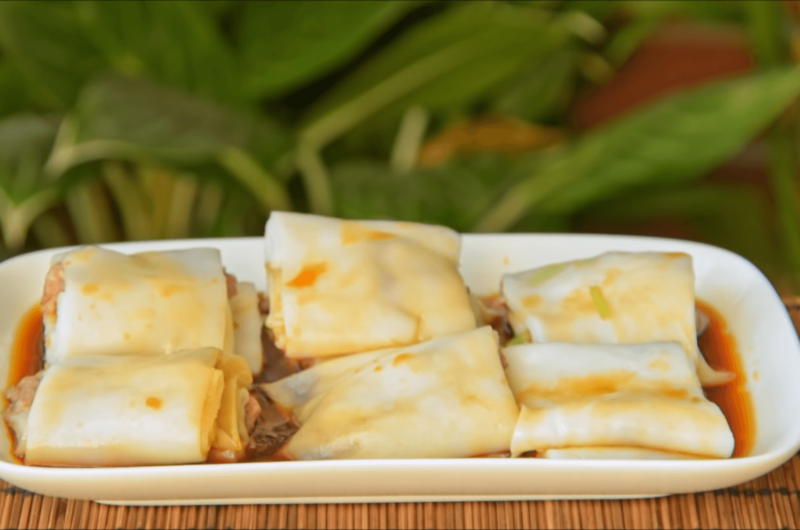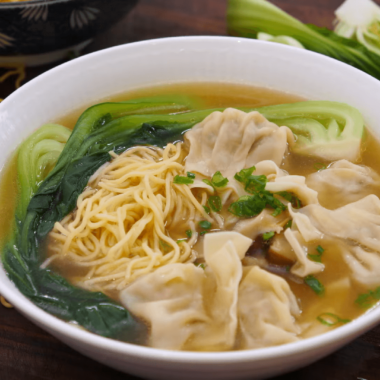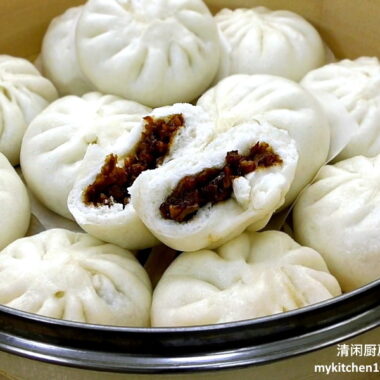A typical Cantonese dish originating from the southern parts of China (including Hong Kong) known as rice noodle roll is a small roll prepared with a wide strip of rice milk that is usually filled with vegetables, beef, pork, or shrimp. The dish can also be made without any fillings, when it’s commonly known as chee cheong fun, literally translated to pig intestine noodle, due to the fact that the noodle is rolled tightly, resembling the small intestine of a pig.
Chinese Rice Noodle Roll | (布拉肠粉 – Bù Lā Cháng Fěn)
Course: Appetizers, MainCuisine: ChineseDifficulty: Medium4
servings30
minutes30
minutes158
kcal1
hourA typical Cantonese dish originating from the southern parts of China (including Hong Kong) known as rice noodle roll is a small roll prepared with a wide strip of rice milk that is usually filled with vegetables, beef, pork, or shrimp. The dish can also be made without any fillings, when it’s commonly known as chee cheong fun, literally translated to pig intestine noodle, due to the fact that the noodle is rolled tightly, resembling the small intestine of a pig.
Ingredients
Aged Basmati -or- aged zhanmi
100g Beef loin
- For the batter(s):
300g ice cold water for the 90% blend,
60g water and 100g hot boiled water for the 10% blend;
5g peanut oil to combine.
- Marinade for the beef:
2 tbsp water,
1/8 tsp baking soda
¼ tsp salt
½ tsp sugar
½ tsp cornstarch
¼ tsp light soy sauce
½ tsp liaojiu a.k.a. Shaoxing wine
½ tsp oyster sauce
1 tsp peanut oil
40g Jiuhuang Yellow Chives -or- scallions
- For the Cheong Fun soy sauce:
200g hot, boiled water;
20g sugar;
100g light soy sauce
20g fish sauce
20g Peanut oil
Directions
- Rinse the rice. Rinse the rice for ~2 minutes until the water turns translucent.
- Soak the rice overnight. Fill your bowl of rice to about an inch over the rice, then let it soak for at least eight hours.
- Drain the rice, then split it into two bowls – one that contains roughly 90% of the rice, and one that contains about 10% of the rice. Splitting the rice doesn’t need to be an exact science – you could even eyeball it.
- In a blender, toss in 90% of the rice together with 300g of cold water. Blend on high – using the smoothie setting if you got it – for three minutes. Strain it through a mesh strainer, then toss in the fridge. The smoothie or puree setting seems to blend this together a bit more evenly. Keeping this stuff in the fridge’s more important if you’re in a hot climate – if things are a bit too sultry, the mixture will start to ferment and sour.
- In a blender, toss in the remaining 10% of the rice together with 60g of water. Blend on high – smoothie setting if possible – for one minute. Then add 100g of hot, boiled water and blend for another two minutes. Strain through a mesh strainer, then toss in the fridge. The hot water gelatinizes the starch in the rice, allowing for a slightly more translucent end result. If you’re feeling lazy, just blend all the rice together with 460g of room temp water. You’ll still get a nice end result.
- Thinly slice the beef against the grain. You’ll want the beef to be as thin as reasonably possible. Don’t worry too much if the beef sort of comes apart into smaller pieces – that’s fine for a Cheong Fun. Thick beef would be inedible.
- Mix in the marinade, stir for ~1 min with your hands, then ‘dat’ for ~30 seconds. Let it marinate for at least 20 minutes.
- Slice the jiuhuang yellow chives -or- scallions. If using Jiuhuang, you only use the middle section of the jiuhuang. Chop off the white end, chop off the wilted end, then cut into 1 cm pieces. If using scallions, slice in ½ cm pieces.
- Prepare the Cheung Fun soy sauce: mix in the sugar with the hot boiled water, then add in the light soy sauce and the fish sauce. Set aside.
- Remove the two batters from the fridge, stir each, combine and toss in the 5g peanut oil. Whisk together. The rice powder has a nasty tendency to settle, so give it all a stir before you do anything important.
- Prepare the cooked peanut oil: toss the peanut oil in a small pot, then heat it up til smoking. Then shut off the heat and reserve. Cooking the peanut oil brings out the nuttiness of the oil.
- Get a pot of water to a rapid boil, then give the batter another stir. You’ll want your steaming set-up to be rolling at full blast, and be sure to give the batter a stir before each steaming.
- If using the cloth method: take a damp cloth and lay over the steamer. Pour in 2 ladles, ~1/3 cup, of batter. Sprinkle on a small amount of jiuhuang/scallions and beef in a rough ‘line’ in the center of the cloth. Steam covered for one minute, then take it out and let it rest for another 30 seconds. Then carefully pull the rice roll off the cloth with a bench scraper, roll it up, and chop into four pieces.
- If using the tray method: preheat the tray for 2-5 minutes in the steamer, then oil it. Pour in 2 ladles, ~1/3 cup, of batter. Sprinkle on a small amount of jiuhuang/scallions and beef in a rough ‘line’ in the center of the cloth. Steam covered for two minutes, then take it out and let it rest for 15 seconds. Roll the Cheung Fun up, and chop into four pieces. So if you’re working with the tray method, the pre-heating basically really need to be only done with the very first steam you do. We pre-heated ours for 5 minutes as it’s a rather thick baking tray.
- After four steamings, prepare a serving by first brushing it with some of the cooked peanut oil.
- Smother it all with the Cheung Fun soy sauce, and devour.






